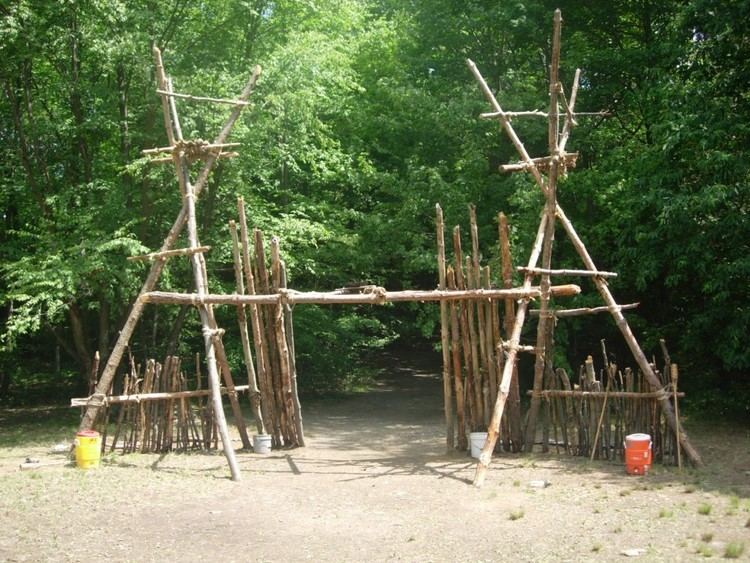In the Scout Movement, pioneering is the art of using ropes and wooden spars joined by lashings and knots to create a structure. Pioneering can be used for constructing small items such as camp gadgets up to larger structures such as bridges and towers. These may be recreational, decorative, or functional.
Pioneering is used to teach practical skills, teamwork and problem solving. It is widely used in Scouting and Girl Guiding. Many Scout and Guide groups train their members in pioneering skills and construct projects, both small and large. In camp, Scouts may construct functional items like tables, camp dressers and gadgets, as well as decorative camp gateways. Pioneering is a common merit badge in many countries, and was required for the Eagle Scout rank in the 1920s and 1930s.
The name comes from the 18th and 19th century military engineers who went ahead of an army to "pioneer" a route, which could involve building bridges and towers with rope and timber (for example the Royal Pioneer Corps).
Pioneering skills include knot tying (tying ropes together), lashing (tying spars together with rope), whipping (binding the end of a rope with thin twine), splicing (joining or binding the end of a rope using its own fibres), and skills related to the use, care and storage of ropes, spars and related pioneering equipment.
There are a number of basic knots used in pioneering:
Bowline
Clove hitch
Reef knot
Sheet bend
Timber hitch
Commen Whipping
There are also a number of specialized pioneering knots that are used to add safety and functionality to pioneering projects:
Butterfly Loop
Carrick Bend
Rolling hitch
Roundturn and Two Half Hitches
Square lashing, which gets its name from the fact the wraps are “square” to the poles. Square Lashings bind poles that are in contact and cross each other at any angle from 45° to 90°
Diagonal lashing, used when securing two spars when they cross but do not touch as in the "X" of an H-frame trestle
Round lashing, used to join two poles in a straight line
Sheer lashing, (also spelled Shear Lashing) used to join two poles in a scissors shape, to be spread out, most often to form the legs of an A-frame
Running Square Lashing, Running Square Lashing is new concept or best revolution and problem solving of running lashing and snake lashing, mean running lashing and snake lashing can't use if the objects are in quite distance. both of this lashing need more line and objects to be complited. Running Square Lashing (RS Lashing) is option for these two lashing. For the first time Rajesh Gaiju (Wood Badger,Rover Leader at Adventure Nepal Open Crwe - ANOC) used this RS Lashing at 2nd Scout Bhaktapur Adventure Trail 2015 (Nepal).
RS Lashing start with Clove hitch on base object an 1 run in another object, then 1 wrap and 1frap and again 1run, 1wrap and 1frap........ end with clove hitch...
These basic structures are the building blocks for a number of pioneering projects:
A-Frame: The basis of many tower structures. The horizontal member of the A-frame also makes a convenient springing point for a deck such as a table-top.
Trestle: Used as a modular element for building bridges and towers. Also used as a 'chariot' for inter-Patrol chariot races. Often referred to as X-Trestle or H-Trestle
Tripod: As end supports for swingbridges, dining tables, etc. and as the basis for the hourglass tower. A tripod is not considered secure unless its legs connected with cross braces, or are staked or otherwise attached to the ground.
Aerial runways
Ballistae
Benches
Bridges
Camp gadgets
Camp gateways
Catapults
Chairs
Chippewa Kitchens
Dressers
Ferris Wheel
Flagpoles
Merry-Go-Rounds
Rafts
See Saws
Swing Sets
Swinging Ships
Tables
Towers
Trebuchets

